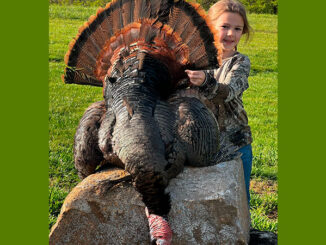
High school junior lands 66-pound fish that breaks record by 12 pounds.
When Larry Verne caught a 54-pound, 2-ounce striper out of Hiwassee Lake back in June of 1991, striper fishermen around North Carolina wondered not just how a fish had gotten that big, but how it had gotten into a lake where stripers had never been stocked.
Few even dared to dream that Verne’s state-record fish – which had been nearly a dozen pounds larger than the previous record-holder – would ever be matched.
On March 31, the same lake where stripers aren’t supposed to live produced a fish that couldn’t possibly be as big as the scales said it was. Just after high noon, not quite a decade after Verne caught his fish from the bank on a live sunfish, Tyler Shields of Murphy, a junior at Hiwassee Dam High School, landed an enormous striper so mind-boggling that it defies description.
Powell Wheeler, a fisheries biologist for the N.C Wildlife Resources Commission who witnessed the fish being weighed officially at 66 pounds even, was awestruck.
“Man, that fish was HUGE,” said Wheeler, who measured the fish at 47-1/2 inches long and 35 inches in girth. “It had more girth than (Shields) did.”
A slender, 6-foot-4, 17-year-old, Shields had no clue what the day had in store when he and a handful of friends piled into three boats and headed out bass fishing on 6,500-acre Hiwassee, a mountain reservoir near Murphy in the extreme western corner of North Carolina. It was about 11:30 when he made his big cast.
“The bass were on the beds, or just coming off,” Shields said, explaining why he was fishing a black Zoom trick worm on a 4/0 Gamakatsu hook, using a Bass Pro Shops Bionic Blade spinning rod and Pfleuger Trion reel spooled with 10-pound test Bass Pro Shops Excel monofilament.
“We were fishing near the head of a hollow, where it came out and met a creek, and I threw to this stump, and saw him come out and eat it.”
Shields assumed when the heavy fish started to take off that he was hooked into a big catfish – he hadn’t gotten that good a look at the fish when it struck; even if he did, it’s doubtful he considered a big striper since he’d never caught one before and there is a limited population in Hiwassee.
“I knew I couldn’t stop him, so we just followed him,” Shields said. “I finally felt like he was coming; he finally came up, and we got him in the net. After we had him in the boat, me and the two other guys (Logan Howard and Caleb Davis), we just stood there and laughed. We couldn’t believe it.”
Shields and company had no idea what he had on board, and it wasn’t until he and the other two boats got back to the dock that somebody suggested that they’d better weigh the fish. A phone call brought the news that the state record fish was a 54-pounder.
“We knew it was a big striper, and some of the other guys said we’d better get it weighed, then somebody called and found out what the state record was,” he said. “We finally got it to a store with certified scales about seven hours after I caught it.”
So what’s a 66-pound striper – two pounds heavier than the state’s saltwater record and bigger than any other landlocked striper ever caught east of the Mississippi River – doing in a lake where its species was never stocked?
When Verne’s state-record striper was caught at Hiwassee in 1991, biologists guessed that the fish had been stocked in Lake Nottely across the border in the mountains of north Georgia, gotten through the dam as a fingerling and into the Nottely River, which runs downstream to Hiwassee Lake.
“It probably got through the dam, but TVA (Tennessee Valley Authority) had some trouble with electric generation (at Nottely) last year, and they had to run some water over the spillway,” Wheeler said.
The Commission has never stocked stripers in Hiwassee, so the lake’s resident population, Wheeler said, is likely confined to a very small number, nowhere near the five to six fish per acre commonly stocked on an annual basis in North Carolina reservoirs that receive fingerlings. Without much competition as the lake’s top-level predator, stripers can attain unusual size.
“We call that density-dependent growth,” Wheeler said. “The fewer there are, the bigger they get. That’s one problem with striper fishing. Everybody wants you to stock more, but if they want bigger fish, that’s the exact opposite of what you need to do.”
Wheeler also said that everything appears in order for the Commission to approve Shields’ application for a state record, which should take a month. “All he’s got to do is get his paperwork in,” he said.





Be the first to comment